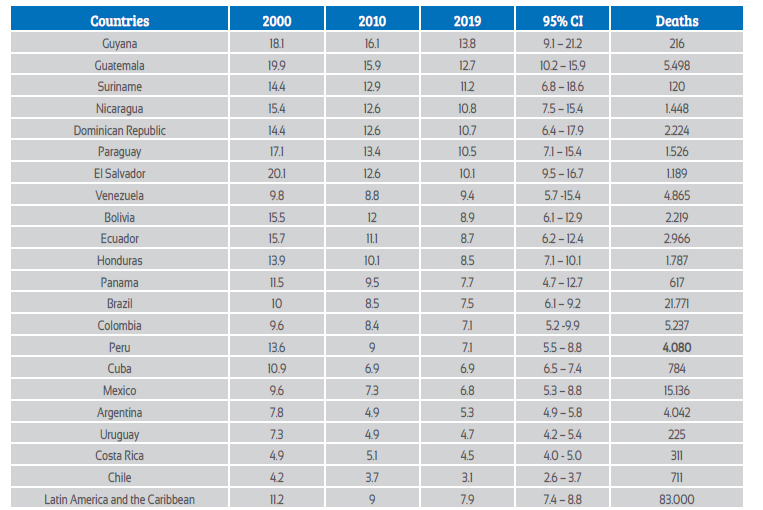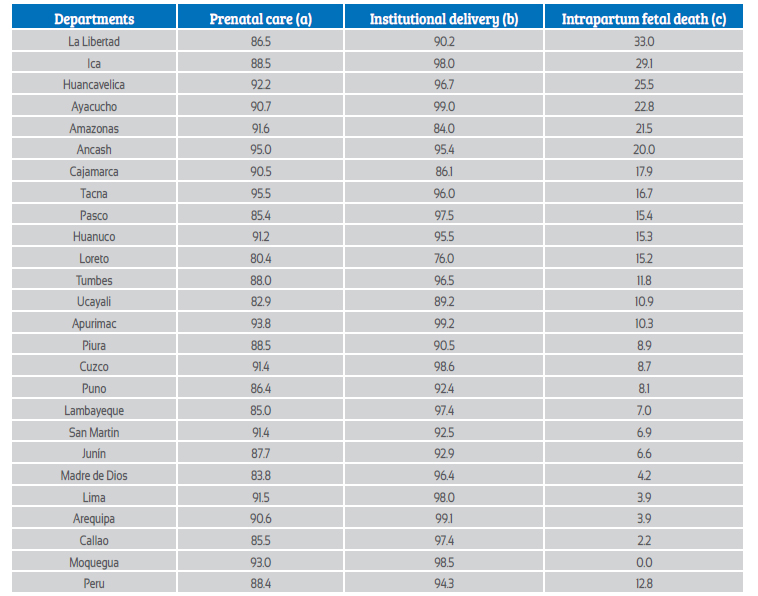Servicios Personalizados
Revista
Articulo
Indicadores
-
 Citado por SciELO
Citado por SciELO
Links relacionados
-
 Similares en
SciELO
Similares en
SciELO
Compartir
Revista Peruana de Ginecología y Obstetricia
versión On-line ISSN 2304-5132
Rev. peru. ginecol. obstet. vol.68 no.4 Lima oct./dic 2022 Epub 30-Nov-2022
http://dx.doi.org/10.31403/rpgo.v68i2462
Letter to the editor
How are we doing in reducing preventable fetal death by 2030?
1Enfermera, especialista en Epidemiología de Campo, Doctor en Salud Pública, Centro Nacional de Epidemiologia, Prevención y Control de Enfermedades, Lima, Perú.
2Médico Cirujano, Ginecólogo-Obstetra. Auditor médico. Hospital Nacional Daniel A.
Dear Editor,
Fetal death (FD) is the death of the product of conception at 22 weeks of gestation or more1 and can occur before delivery or during delivery (intrapartum). Estimates made by the United Nations Inter-agency Group for Child Mortality Estimation (UN IGME) estimate that 2 million stillbirths occurred worldwide in 2019, i.e., 16 FDs occurred every second. Forty percent occurred during intrapartum and most of them could have been prevented with quality prenatal care and adequate delivery care. For Peru, a fetal mortality rate (FMR) of 7.1 per 1,000 births with 4,080 FD of 28 to more weeks of gestation is estimated, placing the country in the lower third of fetal mortality with respect to other Latin American countries2 (Table 1).
Table 1 estimated late fetal death rate in latin america and the caribbean, 2019.

Source: ending preventable newborn deaths and stillbirths by 2030 (un igme) 4
In 2021, the National Center for Epidemiology, Prevention and Disease Control (CDC-Peru) recorded 2,800 late FD and 493 maternal deaths (six times less frequent); moreover, 12.8% of these FD were intrapartum (proportion of intrapartum FM, a sensitive indicator of the delay and low quality of delivery care)3).
One of the targets of the third Sustainable Development Goal is the reduction of preventable fetal mortality by 2030. The WHO-UNICEF action plan ‘Every newborn’ states that by 2030, the countries’ FMR will be 12 stillbirths or less per 1,000 births, and to achieve these goals it proposes monitoring progress in the coverage of some indicators, including ‘four or more prenatal check-ups’ and ‘institutional delivery’4). National and departmental targets are set for coverage of over 70% for prenatal care and 80% for institutional delivery between 2020 and 2025. According to the National Institute of Statistics and Informatics, in 2021 Peru reached 88% coverage of 6 or more prenatal checkups and all departments exceeded 80%. Institutional delivery coverage was 94%, and all departments had coverage above 80%, except Loreto5). These favorable coverage rates do not coincide with the high proportion of intrapartum FD, which exceeds the national average in 13 departments (Table 2).
Table 2 prenatal control coverage, institutional delivery and proportion of intrapartum fetal death, by department, 2021.

Source: (a) and (b) inei-endes 2021. (c) epidemiological surveillance of fetal and neonatal death. cdc-peru.
To reduce preventable FD we must intensify actions to promote healthy lifestyles in mothers-to-be, provide quality prenatal care early, timely, complete and universally accessible -, promote early detection of atrisk pregnancies and timely referral to centers of greater complexity, increase coverage of institutional and skilled delivery, and strengthen professional competencies for the resolution of obstetric emergencies6,7).
In health facilities it is necessary to certify the occurrence of FD, especially intrapartum, given the possibility of prevention and the need for auditing, so we suggest strengthening the national registry of fetal deaths, the quality and coverage of which is far below the certification of neonatal deaths8).
We call on health authorities to place preventable FD on the national policy agenda, intensifying interventions for its reduction and monitoring progress analyzing inequalities between departments and taking care not to leave any behind.
REFERENCES
1. WHO. ICD-11 Reference Guide [Internet]. [cited 2022 Jul 4]. Available from: https://icdcdn.who.int/icd11referenceguide/en/html/index.html [ Links ]
2. United Nations Inter-Agency Group for Child Mortality Estimation, You D, Hug L, Mishra A, Blencowe H, Moran A. A neglected tragedy : the global burden of stillbirths [Internet]. United Nations Children's Fund (UNICEF), editor. New York: UNICEF; 2020 [cited 2022 Jul 4]. 1-86 p. Available from: https://www.unicef.org/reports/neglected-tragedy-glob-al-burden-of-stillbirths-2020 [ Links ]
3. Avila Vargas-Machuca J. Vigilancia epidemiológica de la mortalidad perinatal y neonatal Perú, primer semestre 2022 (SE 1-26) [Internet]. Vol. 31, Boletín Epidemiológico del Perú . 2022 [cited 2022 Aug 7]. Available from: https://www.dge.gob.pe/epipublic/uploads/boletin/boletin_202226_26_125857.pdf [ Links ]
4. WHO UNICEF. Ending preventable newborn deaths and stillbirths. Moving faster towards high-quality universal in 2020-2025. [Internet]. 2020 Jul [cited 2022 Aug 21]. Available from: https://www.unicef.org/media/77166/file/Ending-preventable-newborn-deaths-and-stillbirths-by-2030-universalhealth-coverage-in-2020%E2%80%932025.pdf [ Links ]
5. INEI. Instituto Nacional de Estadistica e Informatica. Perú. Encuesta Demográfica y de Salud Familiar. ENDES 2021 Nacional y Departamental [Internet]. Lima; 2021 [cited 2022 Aug 23]. Available from: https://proyectos.inei.gob.pe/endes/2021/INFORME_PRINCIPAL/INFORME_PRINCIPAL_ENDES_2021.pdf [ Links ]
6. de Bernis L, Kinney M v, Stones W, ten Hoope-Bender P, Vivio D, Leisher SH, et al. Stillbirths: ending preventable deaths by 2030. The Lancet [Internet]. 2016 Feb 13 [cited 2021 May 4];387(10019):703-16. Available from: https://linkinghub.elsevier.com/retrieve/pii/S014067361500954X [ Links ]
7. WHO. Improving measurement of the quality of maternal, newborn and child care in health facilities [Internet]. Vol. 1. 2013 [cited 2022 Jul 2]. Available from: http://apps.who.int/iris/bitstream/handle/10665/128206/9789241507417_eng.pdf?sequence=1 [ Links ]
8. WHO. Making every baby count. Audit and review of stillbirths and neonatal deaths [Internet]. Geneva; 2016 [cited 2021 Apr 30]. Available from: https://www.who.int/publications/i/item/9789241511223 [ Links ]
Disclaimer: The views expressed in this publication do not necessarily reflect the views of the National Center for Epidemiology, Disease Prevention and Control.
Received: July 11, 2022; Accepted: September 27, 2022











 texto en
texto en 



